Honor Award
The Docks: Engaging the Edge at Brooklyn Basin
Michal Kapitulnik, Student ASLA; Catherine McDonald, Student ASLA; Alex Schuknecht, Student ASLA and Robert Tidmore, Student ASLA, Graduate, University of California, Berkeley
Faculty Advisor: Judith Stilgenbauer
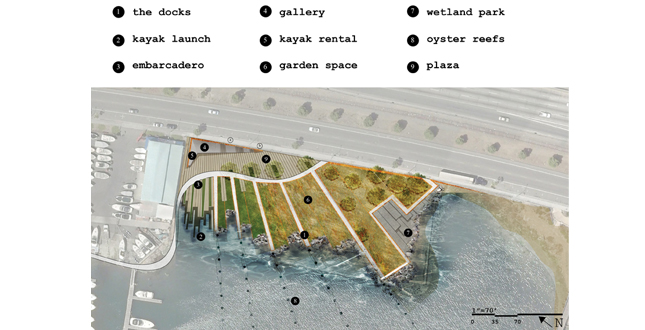
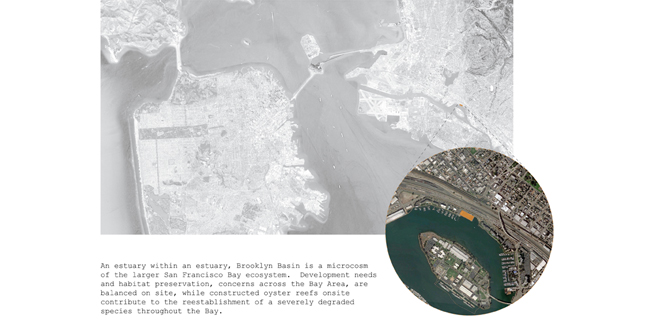 Close Me!
Close Me!Context — An estuary within an estuary, Brooklyn Basin is a microcosm of the larger San Francisco Bay ecosystem. Development needs and habitat preservation, concerns across the Bay Area, are balanced on site, while constructed oyster reefs onsite contribute to the reestablishment of a severely degraded species throughout the Bay.
Download Hi-Res ImageImage: Student Team
Image 2 of 15
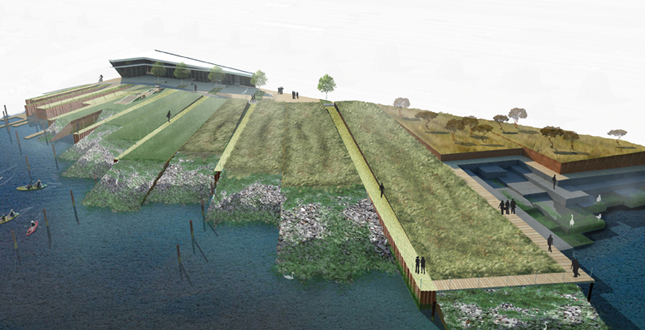 Close Me!
Close Me!Aerial View — Aerial perspective of proposed design during mid-tide at Brooklyn Basin. The multiple gradients that characterize the site overlap and complement one another.
Download Hi-Res ImageImage: Student Team
Image 3 of 15


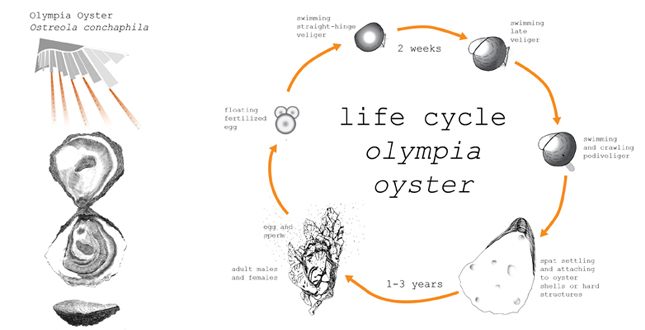 Close Me!
Close Me!Systems — The Olympia Oyster is the native oyster of the Pacific coast of North America, ranging from Alaska to Mexico. Historic harvesting and consumption of oysters was so prevalent in the Bay Area that enormous middens of oyster shells are found throughout the East Bay. The largest shell mound is located in Emeryville, just North of the site. Looking to this legacy as a way of addressing water quality concerns in Brooklyn Basin, new educational and habitat paradigms are cultivated on site
Download Hi-Res ImageImage: Student Team
Image 6 of 15
 Close Me!
Close Me!Sections — Oyster reefs emerge as a new edge to Brooklyn Basin, providing new habitat and opportunities for environmental education.
Download Hi-Res ImageImage: Student Team
Image 7 of 15
 Close Me!
Close Me!Sections — A new intertidal zone increases dynamic edge habitat for birds, plants and aquatic organisms.
Download Hi-Res ImageImage: Student Team
Image 8 of 15
 Close Me!
Close Me!Detailed Plan — "The Boathouse" acts as a new cultural and environmental education center, including a café, kayak rental facility, community gathering space and indoor and outdoor gallery space.
Download Hi-Res ImageImage: Student Team
Image 9 of 15
 Close Me!
Close Me!Details — New details: site infrastructure as sculptural abstraction of the existing architecture of retention on site.
Download Hi-Res ImageImage: Student Team
Image 10 of 15
 Close Me!
Close Me!Signage — Education habitat handouts, neighborhood connections, educational display
Download Hi-Res ImageImage: Student Team
Image 11 of 15

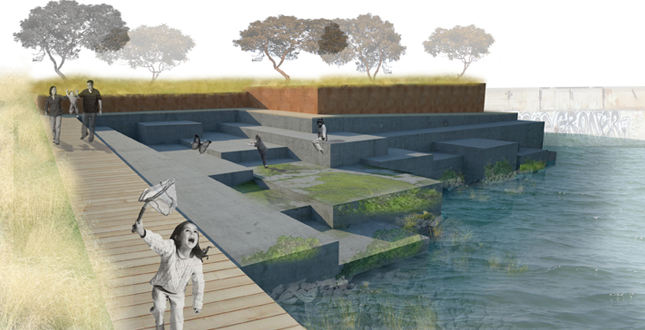 Close Me!
Close Me!Perspectives — Perspective at wetland and terraces
Download Hi-Res ImageImage: Student Team
Image 13 of 15

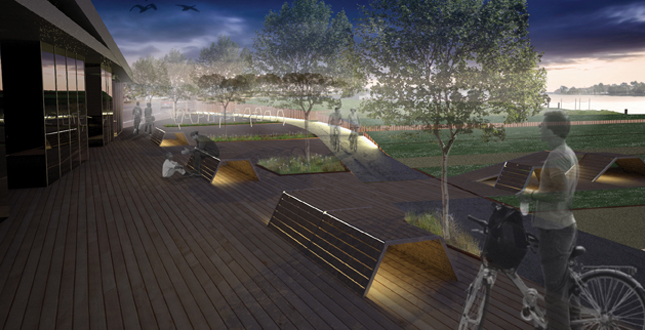
Project Statement
At the threshold of industry, infrastructure, and the degraded water edge, the Bay Trail is fragmented at Brooklyn Basin. Leveraging these rich adjacencies, the proposed design opens up access to the Bay and knits the trail back together through a series of docks, piers and gardens. The Bay edge is transformed to create increased diversity of terrestrial and aquatic habitats. Immersive tectonic experiences arise, providing spaces for cultural and educational engagement while promoting stewardship.
Project Narrative
—2011 Student Awards Jury
Background
The Oakland Waterfront is currently in a state of disrepair and neglect. The 880 Freeway acts as a dividing barrier between the Bay and the rest of the city, cutting off waterfront access. The regional Bay Trail, one of the few points of public access to the waterfront, is disrupted at Brooklyn Basin. A stormwater outfall is located directly South of the site, and discharges contaminated runoff to the Bay. Despite these harsh conditions, a novel wetland ecology has established a delicate foothold, and serves as vital habitat. Surrounding artist collectives in Jingletown, Jack London Square and Alameda provide a rich community-based resource in the area. The 1.5 acre site is a capped fill abandoned lot armored on two sides with steel pile retaining walls.
Design Intent / Design Framework
The proposed design leverages rich programmatic adjacencies to create a new open-space paradigm on site. Redistributing the geology of detritus on-site, the Bay edge is pulled out and pushed back to create a dynamic edge condition that balances the cut and fill on site. This new edge establishes a diverse habitat gradient on both land and in water, to catalyze cultural and social uses on site.
In addition, a system of piers and an embarcadero emerges as the spacial organization for habitat and program. The piers and embarcaderos create immersive tectonic experiences that serve to foster interaction and recreation at the water’s edge while also creating habitat. Between the docks that project out into the water, a series of gardens are inset that provide both educational and immersive experiences.
Habitat gradients underlay the spacial organization of the design. Within the aquatic habitat zone, habitat morphs from tidal marsh and wetland to subtidal oyster reefs, providing increased diversity and productivity. On land, the gardens host to two complementary gradients: they transition from upland habitat to lowland wet meadows, and garden access fluctuates from fully accessible kayak docks(lowland) to inaccessible raised garden beds that treat contaminated soil (upland).
Gardens
Potentially contaminated fill material excavated from the site is placed in raised garden beds at the southeastern end of the site. These raised beds create an upland coastal scrub habitat with manzanita and pacific hairgrass. The upland zone transitions to a grassland plant community dominated by fescue and sedge, which would permit limited human use. As the raised beds subduct into the groundplane, the grassland morphs into a clover lawn surface that would attract recreation. Finally, each garden transitions from its upland plant community to a tidal marsh habitat at the Bay’s edge.
Embarcadero Piers and Docks
As an extension of the aquatic gardens on site, a system of piers and docks create access points for park users. The park’s program operates on an accessibility gradient, with more concentrated public use occurring in the northwest corner. This gradient is reflected in the concentration of piers and docks that increase in the northwest and allow park users to easily access the waterfront through floating kayak docks that move vertically with the tides. Didactic signage is embedded within the embarcadero wall system, educating users about emergent site ecologies as well as providing neighborhood-scale connections and way-finding.
Wetlands to Oyster Reefs
The aquatic habitat gradient on site transforms from tidal marsh and wetland in the southeast to subtidal Olympia oyster reefs in the northwest. The stormwater outfall on site provides seasonal freshwater inflows and sediment fluxes to regenerate the tidal marsh. In our design, the existing tidal marsh is enlarged and protected by an extension of the pier and garden system that buffer the wetland cove. Directly adjacent to the tidal marsh is a constructed wetland terrace system that provides an interactive physical and visual experience with tidal changes in the Bay. Gently sloping concrete platforms create zones for algae and sea grass colonization. The lower terraces are graded into gently sloping tidal marshes.
Plaza and Trail Connections
The proposed design re-establishes the regional Bay Trail as a continuous network for waterfront access and recreation. The fragmented trail is re-routed through the site and connects the northern and southern portions of the trail. The trail serves as the division between the hardscape plaza and the gardens. The "Boathouse" frames the site and provides a buffer between the adjacent freeway and park. The building's programs (an art gallery, juice bar and kayak rental) serve the adjacent artist communities, and commuters on the Bay Trail. Sunken rain gardens capture and treat runoff from the plaza.
Materials and Details
Site furnishings and materiality reference the existing architecture of retention and degradation that mark the existing edge of Brooklyn Basin. Weathered steel-pile retaining walls on site are repurposed to create reinforced edges for the uplifted gardens and piers. A path system that runs along the top of the piers is surfaced with crushed fill debris from the site. Recycled wood decking on the plaza and kayak docks recreate the waterfront character of the site. The same recycled wood is used to create the interactive seating and activity surfaces. Throughout the site, recessed and ambient lighting creates a dynamic atmosphere for night-time uses of the site and trail system.
Additional Project Credits






